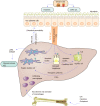Macrophages in metabolic associated fatty liver disease
- PMID: 32390698
- PMCID: PMC7201150
- DOI: 10.3748/wjg.v26.i16.1861
Macrophages in metabolic associated fatty liver disease
Abstract
Metabolic associated fatty liver disease (MAFLD), formerly named non-alcoholic fatty liver disease is the most common liver disorder in many countries. The inflammatory subtype termed steatohepatitis is a driver of disease progression to cirrhosis, hepatocellular carcinoma, liver transplantation, and death, but also to extrahepatic complications including cardiovascular disease, diabetes and chronic kidney disease. The plasticity of macrophages in response to various environmental cues and the fact that they can orchestrate cross talk between different cellular players during disease development and progression render them an ideal target for drug development. This report reviews recent advances in our understanding of macrophage biology during the entire spectrum of MAFLD including steatosis, inflammation, fibrosis, and hepatocellular carcinoma, as well as for the extra-hepatic manifestations of MAFLD. We discuss the underlying molecular mechanisms of macrophage activation and polarization as well as cross talk with other cell types such as hepatocytes, hepatic stellate cells, and adipose tissue. We conclude with a discussion on the potential translational implications and challenges for macrophage based therapeutics for MAFLD.
Keywords: Fibrosis; Hepatic stellate cells; Inflammation; Macrophages; Metabolic associated fatty liver disease.
©The Author(s) 2020. Published by Baishideng Publishing Group Inc. All rights reserved.
Conflict of interest statement
Conflict-of-interest statement: The authors declare no competing interests for this manuscript.
Figures


References
-
- Eslam M, Newsome PN, Anstee QM, Targher G, Gomez MR, Zelber-Sagi S, Wong VW, Dufour JF, Schattenberg J, Arrese M, Valenti L, Shiha G, Tiribelli C, Yki-Järvinen H, Fan JG, Gronbaek H, Yilmaz Y, Cortez-Pinto H, Oliveira CP, Bedossa P, Adams LA, Zheng MH, Fouad Y, Chan WK, Mendez-Sanchez N, Ahn SH, Castera L, Bugianesi E, Ratziu V, George J. New definition for metabolic associated fatty liver disease: an international expert consensus. J Hepatol. 2020 - PubMed
-
- Eslam M, Sanyal AJ, George J International Consensus Panel. MAFLD: A Consensus-Driven Proposed Nomenclature for Metabolic Associated Fatty Liver Disease. Gastroenterology. 2020 - PubMed
-
- Sarin SK, Kumar M, Eslam M, George J, Al Mahtab M, Akbar SMF, Jia J, Tian Q, Aggarwal R, Muljono DH, Omata M, Ooka Y, Han KH, Lee HW, Jafri W, Butt AS, Chong CH, Lim SG, Pwu RF, Chen DS. Liver diseases in the Asia-Pacific region: a Lancet Gastroenterology & Hepatology Commission. Lancet Gastroenterol Hepatol. 2020;5:167–228. - PMC - PubMed
-
- Estes C, Anstee QM, Arias-Loste MT, Bantel H, Bellentani S, Caballeria J, Colombo M, Craxi A, Crespo J, Day CP, Eguchi Y, Geier A, Kondili LA, Kroy DC, Lazarus JV, Loomba R, Manns MP, Marchesini G, Nakajima A, Negro F, Petta S, Ratziu V, Romero-Gomez M, Sanyal A, Schattenberg JM, Tacke F, Tanaka J, Trautwein C, Wei L, Zeuzem S, Razavi H. Modeling NAFLD disease burden in China, France, Germany, Italy, Japan, Spain, United Kingdom, and United States for the period 2016-2030. J Hepatol. 2018;69:896–904. - PubMed
-
- Wong RJ, Aguilar M, Cheung R, Perumpail RB, Harrison SA, Younossi ZM, Ahmed A. Nonalcoholic steatohepatitis is the second leading etiology of liver disease among adults awaiting liver transplantation in the United States. Gastroenterology. 2015;148:547–555. - PubMed
Publication types
MeSH terms
LinkOut - more resources
Full Text Sources
Medical

